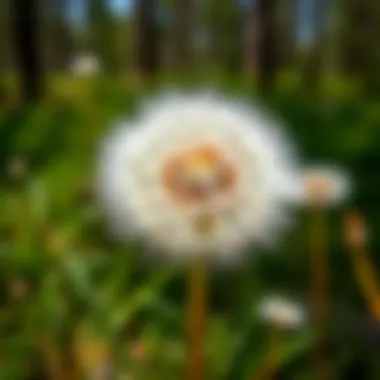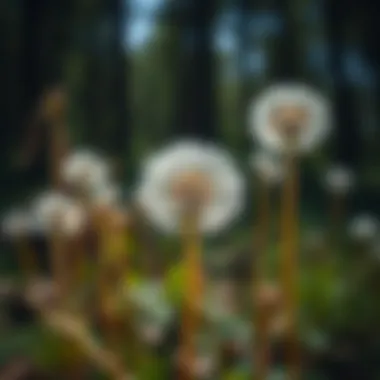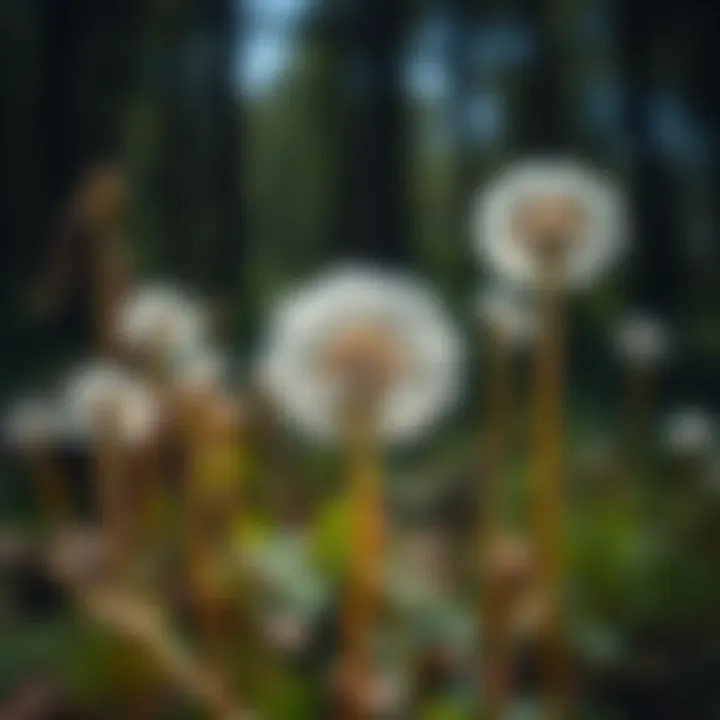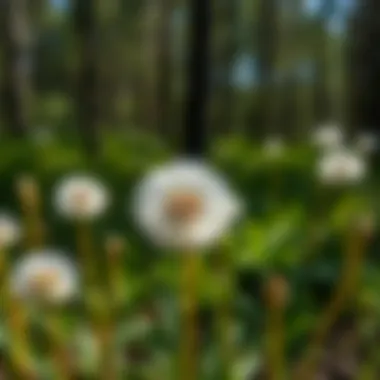Exploring Dandelion Facts and Their Significance


Intro
Dandelions often get a bad rap, commonly labeled as pesky weeds that clutter well-manicured lawns. However, behind this facade lies a plant that is rich in ecological, medicinal, and cultural significance. This article aims to peel back the layers of misconceptions surrounding dandelions, revealing their multifarious roles in our environment. Exploring their biological characteristics and contributions to biodiversity illuminates the vital place dandelions hold not just in nature, but in human history and uses.
Forest Ecology and Biodiversity
Dandelions thrive in a variety of settings, including woodlands. Dedicating attention to their contributions within forest ecology can enrich our understanding of these ecosystems.
Importance of Forest Ecosystems
Forests cover about 31% of the Earth's surface and are indispensable to life. They provide habitat for a multitude of species and act as carbon sinks, playing a critical role in combating climate change. Dandelions contribute to soil health, and their deep taproots help to prevent soil erosion, thereby stabilizing the delicate forest undergrowth.
Flora and Fauna in Woodlands
Dandelions serve as a food source for various organisms including bees, butterflies, and other pollinating insects. They attract these vital species, supporting pollination processes crucial for many other plants in the ecosystem. Furthermore, dandelions have been shown to promote soil biodiversity—a healthier soil often results in healthier food systems.
Foreword to Dandelions
Dandelions are more than just a common sight in gardens and meadows; they play a vital role in various ecosystems across the globe. Often dismissed as mere weeds, dandelions possess a multitude of benefits that merit deeper understanding and appreciation. From their remarkable adaptability to changing environments to their contributions to soil health and nutrition, dandelions secretly support life in ways that many are oblivious to.
Understanding the biological and ecological aspects of dandelions enhances our knowledge of plant life and its impact on our surroundings. Their presence can indicate soil conditions and help in maintaining biodiversity. As we delve into the classification and nomenclature of dandelions, we can grasp the historical and cultural significance attached to them, thus providing a rounded perspective on why we should reconsider their status in our gardens and landscapes.
In the forthcoming sections, we’re set to embark on a journey that examines dandelions from multiple angles, highlighting their interconnections with nature and humanity. Each aspect discussed will showcase their undeniable importance in contributing to a healthier ecosystem and, ultimately, our lives.
Definition and Classification
Dandelions, belonging to the Asteraceae family, are classified under the genus Taraxacum. This classification includes roughly 60 species that are primarily found in temperate regions. The term "dandelion" originates from the French name dent de lion, which means "lion's tooth", a nod to the jagged edges of the leaves.
These plants exhibit a unique growth cycle, typically characterized by a rosette of leaves and a stem that emerges to support bright yellow flower heads. Dandelions thrive in a variety of conditions, demonstrating a remarkable tolerance for poor soil and adverse weather.
Dandelions can be categorized as perennial herbs, recognized for their resilience and ability to reproduce effectively through seeds and vegetative propagation. Such characteristics underscore their ecological significance, helping them to adapt and flourish in diverse environments.
Common and Scientific Names
The common name, dandelion, may evoke images of sunny fields or backyard battles in pursuit of a pristine lawn. However, its scientific designation, Taraxacum officinale, gives a nod to its medicinal uses. Across different cultures, dandelions are referred to by various names, each reflecting local flora and traditions.
- Common Names:
- Scientific Classification:
- Dandelion
- Lion's Tooth
- Puff Ball
- Kingdom: Plantae
- Phylum: Angiosperms
- Class: Eudicots
- Order: Asterales
- Family: Asteraceae
- Genus: Taraxacum
- Species: T. officinale
This classification emphasizes the plant's diversity and adaptability, as different species under the genus Taraxacum have been identified worldwide. Such vastness in identification invites inquiry into each species' unique contributions to local ecosystems and their interactions with various organisms.
"Dandelions serve as nature's untapped resource—infinitely versatile and often overlooked."
As we move forward, we will explore the various biological characteristics of these plants, assessing their reproductive strategies and the complexities of their root systems, to understand better the profound impact dandelions have on their environment.
Biological Characteristics of Dandelions
Understanding the biological characteristics of dandelions is crucial for grasping their significance in various ecosystems. These unique plants present a wealth of adaptations that enable them to thrive in diverse environments. From morphological features to reproductive strategies, dandelions exhibit remarkable traits that underscore their importance in maintaining ecological balance.
Morphology and Physical Features
Dandelions possess a distinctive appearance that makes them easy to identify. Their rosette of deeply lobed leaves grows close to the ground, serving as a base for the tall flower stalks that can reach heights of up to twelve inches. Each flower head consists of numerous densely packed yellow florets, which, when pollinated, give way to the familiar white puffball of seeds. This transformation is not merely an aesthetic one; it plays a vital role in dispersal.
Physically, dandelions are built to endure. The leaves are serrated; this design helps in rainwater collection and reduces water loss—a significant advantage in varying climates. Additionally, their bright yellow flowers serve not just as a source of beauty but attract pollinators, increasing their efficiency in reproduction. Furthermore, dandelions can adapt to various soil types, which enhances their capacity to colonize new areas hastily.
Reproductive Strategies
Dandelions utilize both sexual and asexual reproduction, showcasing their resilience and versatility. They primarily reproduce through a method called apomixis, wherein seeds develop without fertilization. This means that a single dandelion can produce a multitude of seeds that are genetically identical to the parent plant, allowing populations to expand rapidly without needing other plants for cross-pollination.
During the flowering season, dandelions deploy a symphony of yellow blooms that beckon bees and other pollinators. Once pollinated, the flower heads transform into fluffy seed heads, adeptly designed for wind dispersal. The seeds can travel significant distances, potentially transforming barren landscapes into flourishing patches of green. This duality in reproductive methods—both external in the form of pollination and internal through apomictic seed production—enables dandelions to effectively thrive in competitive environments.
Root System Structure
The root system of dandelions is essential for their survival and expansion. Dandelions have a taproot that can extend several feet into the soil, enabling them to access nutrients and water far below the surface. This deep anchoring system not only supports the plant’s structure but also contributes to soil aeration and nutrient cycling—benefits that ripple through the ecosystem.


The thick taproot stores energy, allowing these plants to survive adverse conditions. In times of drought or poor soil, the roots ensure that the plant can withstand the stresses and maintain vitality, which can positively affect a broader range of organisms in the surrounding community.
Dandelions are not just weeds; they are a cornerstone species that helps to support soil health and biodiversity.
Overall, the biological characteristics of dandelions reflect a well-adapted plant that plays significant roles in ecological settings. Their morphology, reproductive strategies, and root structure come together to foster resilience and adaptability, qualities that are paramount in both wild and managed landscapes.
Ecological Importance of Dandelions
Dandelions play an understated yet vital role in ecosystems across the globe. Commonly perceived as mere weeds, these resilient plants contribute significantly to various ecological dynamics. Their importance extends beyond their vibrant yellow blooms, embodying multiple functions that support biodiversity and ecosystem health. Understanding these contributions can transform perceptions about dandelions, shedding light on their essential role in maintaining balance in natural environments.
Role in Biodiversity
Dandelions serve as a foundational species in many ecosystems, aiding in the support of biodiversity. This plant thrives in diverse habitats, making it a key player in the survival of various wildlife. The presence of dandelions encourages a greater variety of species within a given area.
- Habitat Provision: Dandelions provide habitat and shelter for small organisms such as insects and spiders, which rely on these plants for sustenance and protection.
- Food Source: For many herbivores and pollinators, dandelion leaves, flowers, and seeds are a critical food source. Animals like rabbits and deer graze on dandelion foliage, while bees and butterflies seek nectar from their vibrant flowers.
- Nutrient Cycling: By their very nature, dandelions contribute to nutrient cycling within ecosystems. Their deep taproots break up compact soil, allowing for better water penetration and enhancing nutrient retrieval from deeper soil layers, enriching the topsoil.
Dandelions’ adaptability and rapid growth cycle enhance the resilience of ecosystems, providing stability in the face of environmental changes. This makes them an integral part of our natural world, which deserves recognition in conservation efforts.
Attracting Pollinators
The colorful flowers of dandelions serve as beacons for pollinators, fulfilling a critical role in the life cycles of many species. When dandelions bloom in spring, they are one of the first sources of nectar available, which is crucial for many insects emerging from hibernation. The simple structure of their flowers allows easy access for various pollinators, such as:
- Honeybees: These industrious insects rely on dandelions as a primary food source early in the season, helping to kickstart their foraging activities.
- Native Bees: Many native bee species prefer dandelions due to their nutritional value, supporting local ecosystems.
- Butterflies: Through their high nectar content, the flowers also attract several species of butterflies, contributing to pollination and genetic diversity of numerous plants as they move from flower to flower.
By fostering populations of pollinators, dandelions enhance the overall productivity of ecosystems. This interconnectedness showcases how even the simplest of organisms can have profound impacts on the environment.
Soil Health Contributions
Dandelions also hold significance in promoting soil health, which is a crucial aspect of ecological balance. Their extensive root systems play a fundamental role in maintaining soil structure and fertility. Consider the following contributions:
- Soil Aeration: The taproot of the dandelion can penetrate deep into the ground, creating channels that facilitate air and water movement. This aeration improves the overall health of the soil by enhancing microbial activity crucial for nutrient breakdown.
- Nutrient Accumulation: Dandelions are known for their ability to absorb nutrients from the deeper soil layers, particularly valuable minerals like potassium and phosphorus. When the leaves and roots die back, these nutrients return to the upper soil, enriching it for future plant growth.
- Erosion Control: The formidable root system of dandelions helps anchor the soil, preventing erosion. This is especially important in the management of urban landscapes and gardens, where soil erosion can pose a significant challenge.
To sum up, dandelions are not just common garden plants, but essential players in supporting biodiversity, attracting pollinators, and enhancing soil health. By acknowledging their ecological importance, we can shift our perspective on these often-maligned plants and appreciate their contributions to sustaining healthy ecosystems.
"Dandelions are the unsung heroes of the garden, quietly supporting life in myriad ways."
For further reading on dandelions and their ecological roles, consider exploring Britannica and Wikipedia.
Medicinal Uses of Dandelions
Dandelions might be best known for their deep yellow blooms and fluffy seed heads, yet their medicinal potential is often eclipsed by their reputation as a weed. These bright little plants pack quite a punch when it comes to health benefits, offering a range of applications from nutrition to traditional remedies. Here, we delve into the various ways dandelions can improve health and well-being, underscoring their significance in both modern medicine and historical practice.
Nutritional Value
Dandelions are far more than a common sight on the lawn; they’re nutritional powerhouses. Consumed entirely, their roots, leaves, and flowers all bring different benefits to the table.
- Vitamins and Minerals: Dandelion greens are brimming with vitamins A, C, and K, as well as potent minerals like potassium and calcium. Just a handful can provide a surprising boost to one’s daily nutrient requirements.
- Antioxidants: The presence of antioxidants in dandelions helps to combat oxidative stress in the body, protecting it from cellular damage. Quercetin and beta-carotene found in these plants contribute to their health-promoting properties.
- Fiber Content: With a decent amount of fiber, particularly in the roots, they benefit digestion while promoting gut health. This characteristic makes dandelions a delightful addition to various diets.
Incorporating dandelions into meals is simpler than you might think; they can be tossed into salads, brewed in teas, or even blanched for a lighter taste. The possibilities are nearly endless for those willing to embrace these versatile plants in their culinary explorations.
Traditional Herbal Practices
Dandelions have a long-standing history in herbal medicine, utilized by various cultures for their therapeutic properties. Traditionally, dandelions were valued as a remedy for various ailments, showcasing their integral role in folk medicine.
- Detoxification: Traditionally, dandelion root was used as a liver tonic. Many herbalists today still promote this idea, claiming that it aids in detoxifying the liver and gallbladder.
- Digestive Aid: Often administered as a natural diuretic, dandelions can help to stimulate digestion. The bitter compounds in the leaves may promote the secretion of digestive juices, hence improving overall digestive efficiency.
- Pain Relief: Some cultures employed dandelions as an anti-inflammatory remedy. The plant’s latex is sometimes used for relieving skin ailments or minor infections.
Following the footsteps of ancestors, modern herbalists create tinctures, teas, and salves with dandelion to harness their curative powers. This practice reminds us that sometimes nature has the best remedies, fostering a respect for the healing capabilities lying right beneath our feet.
Scientific Research Insights
Contemporary research is slowly shedding light on the traditionally held beliefs regarding dandelions, with scientific studies unveiling their potential health benefits. While more extensive studies are necessary, emerging findings point towards several areas of interest.
- Anti-Cancer Properties: Preliminary studies suggest that dandelion extract may contribute to inhibiting cancer cell proliferation. Research conducted at the University of Windsor indicates that dandelion root extract effectively targets and kills certain cancer cells, a promising avenue for future cancer therapeutics.
- Blood Sugar Regulation: There seems to be early evidence suggesting that dandelions may help regulate blood sugar levels, which could be beneficial for individuals with diabetes. Although results are in the nascent stages, this could be an essential topic for further exploration.
- Cholesterol Management: Another area of inquiry includes the effect of dandelions on cholesterol levels—initial studies indicate that they might support healthy cholesterol regulation, offering a natural adjunct to maintaining heart health.
As science continually opens new doors, dandelions may emerge as vital allies in the quest for holistic health solutions. The potential for future applications invites further scrutiny, promising that these yellow blooms are much more than just weeds.
"Dandelions remind us that beauty and utility can often dwell in the unlikeliest of places."
In summary, whether exploring their nutrient density, respecting their historical use, or noting their scientific backing, the medicinal uses of dandelions present a compelling narrative reinforcing their worthiness in both fields of traditional and contemporary health practices.


Cultural Significance of Dandelions
The cultural importance of dandelions stretches across various societies and epochs. This often-overlooked flower has played a significant role in folklore, history, and even in culinary practices. By delving into their historical context and celebrated legends, we can uncover how dandelions have woven themselves into human culture.
Historical Perspectives
Historically, dandelions have been both revered and reviled. In the early days, they were often viewed as a symbol of resilience and vitality. Ancient Romans, for instance, utilized dandelion leaves for their nutritional properties and healing capabilities. Not merely weeds in gardens, they were often included in early herbal texts, illustrating their value in traditional medicine.
As societies progressed, the perception of dandelions evolved. They were frequently regarded as pests by farmers seeking to cultivate crops. However, their ability to thrive in numerous environments and soil types made them emblematic of nature’s stubbornness and adaptability. This duality reflects humanity's relationship with nature, wrestling with the beneficial and the burdensome aspects of these plants.
"In many cultures, dandelions represented hope and determination, especially in times of adversity."
Interestingly, they also gained prominence in cultures across different continents, acting almost like a universal botanical language. For example, in China, dandelions are often associated with the idea of overcoming challenges, as referenced in ancient poetry. This cultural embedding of dandelions enriches our understanding of their significance beyond mere biology or ecology.
Dandelions in Folklore
Dandelions have found a cozy spot in the heart of folklore from various cultures, often laden with symbolism. In many traditions, blowing the seeds from a dandelion puff is believed to carry one’s wishes to the heavens. This simple act connects dreamers with the cosmos, offering a moment of reflection and hope.
In Celtic folklore, the dandelion was viewed as a bridge between realms, believed to help souls find their way. Similarly, in Native American cultures, the plant has been incorporated into various rituals, underscoring its connection to healing and renewal.
In modern tales, children often view dandelions as ideal instruments for imaginative play. The delightful contrast of the golden-yellow blooms against lush green grass captures the essence of childhood wonder. Characters like the whimsical Dandelion Fairy appear in stories, enchanting kids while presenting dandelions as magical entities.
Moreover, their unpretentious nature symbolizes humility and the often overlooked beauty in everyday life. In a world quick to judge based on appearances, dandelions remind us of the hidden stories and worth found in simple things.
In summary, dandelions possess a rich cultural tapestry that intertwines with the human experience. By understanding their historical significance and place in folklore, we can fully appreciate how dandelions have shaped cultural landscapes throughout time.
For those interested in further exploring the role of dandelions in culture, consider visiting Britannica or Wikipedia.
Dandelions and Woodland Stewardship
Dandelions, often cast aside as mere nuisances, play a surprisingly pivotal role in woodland stewardship. Their presence in forest ecosystems is not just an aesthetic matter; it strikes at the very core of ecological balance. Understanding how dandelions contribute to the health of these environments can reshape the perceptions around these so-called weeds, highlighting their benefits while shedding light on their management in woodlands.
Management Strategies
Managing dandelions requires a nuanced approach that acknowledges their ecological functions rather than dismissing them as invasive weeds. Several strategies can be employed to maintain healthy woodland areas while allowing space for these plants:
- Selective Cultivation: Instead of eradication, thining out dandelion populations can promote diversity. This approach allows native flora to thrive without the complete removal of dandelions, which can stabilize soil and enhance nutrient levels.
- Natural Herbicide Use: Incorporating eco-friendly herbicides can manage dandelion growth without hammering the entire ecosystem. Certain organic herbicides target dandelions specifically, limiting collateral damage to surrounding flora.
- Holistic Care Practices: Emphasizing the planting of native species alongside dandelions can encourage a balanced ecosystem, fostering interdependent relationships among flora and fauna.
In shaping management practices, practitioners must remain vigilant about the ecological benefits dandelions lend to woodlands. Their extensive root systems not only improve soil structure but also aid in retaining moisture, thus benefiting surrounding plants.
Balancing Biodiversity and Aesthetics
Aesthetically, dandelions present a vibrant splash of yellow in the often green-dominated woodland palette. However, this beauty must be balanced with concerns over biodiversity.
One critical aspect is to accept that dandelions can serve as a food source for various insects, including bees. They bloom earlier than many other plants in spring, providing essential nourishment when other food sources are scarce. This interplay contributes to a robust ecosystem, as dandelions can support pollinator populations crucial for the reproduction of numerous wild plants.
Additionally, dandelions can act as indicators of soil health. A flourishing dandelion population may signify good soil moisture and fertility, while sparse growth might alert woodland stewards to underlying issues.
By embracing dandelions, woodland managers can create environments that are not only visually appealing but also rich in biodiversity. An understanding that aesthetics and ecological integrity can coexist will foster a more harmonious approach to woodland stewardship.
"The more we validate the place of dandelions in our landscapes, the better equipped we are to nurture resilient ecosystems."
Dandelion Advocacy in Modern Conservation
Dandelions are often brushed off as mere nuisances in gardens and lawns, yet their advocacy in modern conservation efforts sheds light on a much larger narrative. By recognizing the ecological contributions of these plants, we can better understand the interconnectedness of species and habitats. Understanding the importance of dandelions transcends their physical presence in ecosystems; it propels a wider discussion on biodiversity and sustainable practices.
Encouraging Positive Perceptions
The journey towards fostering positive perceptions of dandelions starts with education. Many view dandelions through a negative lens, associating them with disorder in well-manicured lawns. However, changing the narrative around these plants is crucial. Dandelions serve as indicators of healthy soil and can thrive even in compacted, nutrient-poor soils. Their resilience reflects the ability of nature to adapt and thrive, showcasing a unique strength worth embracing.
Educators and conservationists can advocate for awareness programs that engage communities in appreciating dandelions. Initiatives may include workshops and hands-on experiences, emphasizing the plant’s role as a food source for pollinators. For instance, honeybees depend on dandelion nectar when they emerge in early spring when other blossoms are scarce. These small revelations can shift perspectives, transforming dandelions from unwanted weeds to celebrated allies in fostering biodiversity.
Utilization in Sustainable Practices
Integrating dandelions into sustainable practices offers a variety of advantages that align with conservation goals. This species thrives in diverse environments, meaning it can be cultivated, used, and appreciated in many ways. Key applications include the following:
- Nutrient Management: Dandelion roots penetrate deep into the ground, effectively drawing up nutrients that enrich the topsoil. This natural process supports soil health by preventing erosion and promoting organic matter retention.
- Functional Foods: Dandelions are not just weeds; they can be harvested for their edible leaves, flowers, and roots. Rich in vitamins A, C, K, and minerals like potassium and iron, they can be integrated into diets, supporting plant-based food trends.
- Natural Dyes: The yellow flowers can produce vibrant natural dyes for textiles, thus promoting eco-friendly crafts.
- Medicinal Uses: Historical uses of dandelions in herbal medicine for liver detox can be expanded upon, aligning with growing interests in natural remedies.
The continued use and awareness of dandelions in sustainable practices showcase their practicality in environmental management. This not only promotes conservation but can also bolster public support for policies that endorse native flora in urban landscapes.


Challenges Facing Dandelions
Dandelions, often seen as mere weeds, stand at the crossroads of environmental science and agricultural practice. Understanding the challenges they face is crucial not only for appreciating their role in our ecosystems but also for ensuring their survival against external pressures. As urbanization constantly expands and agricultural practices evolve, dandelions encounter a myriad of obstacles that warrant a closer look.
Invasive Species Concerns
Dandelions are native to Eurasia but have successfully spread across the globe, leading to their classification as an invasive species in some regions. While their ability to flourish in various environments is impressive, it raises several ecological issues. An invasion occurs when a non-native species disrupts local ecosystems, competing for resources and potentially displacing native plants. For example, in parts of the United States, dandelions can outcompete indigenous flowering plants, which might reduce biodiversity.
Concerns escalate when we think about soil health. Dandelions are known for their deep roots that help aerate soil and bring nutrients to the surface; yet, their dominance in an ecosystem can sometimes hinder the growth of more vulnerable species. Natural habitats like grasslands, where native plant diversity plays a critical role, may suffer greatly as dandelions proliferate unchecked. Management strategies must focus on maintaining balanced ecosystems by monitoring dandelion populations, ensuring they do not outcompete local flora.
Herbicide Use and Its Impact
The widespread use of herbicides presents another significant challenge for dandelions. Herbicides are often employed to manage unwanted vegetation, which includes dandelions. However, this approach can be a double-edged sword. Using chemicals like glyphosate can lead to unintended consequences that extend beyond the target plants. These substances do not discriminate; many herbicides can harm beneficial insects, pollinators, and even neighboring plants.
Moreover, the frequent application of herbicides can lead to herbicide-resistant strains of dandelions, creating a cycle that may require stronger and newer chemicals to control them effectively. For forest managers and conservationists, this is alarming. They are tasked with finding the balance between managing invasive species and preserving the health of the ecosystem.
"Continuous chemical treatment can degrade soil health and lead to the loss of biodiversity, highlighting the need for integrated pest management strategies that respect ecological balances."
Considering alternative methods, like mechanical removal or integrated pest management strategies, can provide more sustainable solutions. Land managers can also promote practices that enhance the resilience of native vegetation, thereby negating the need for chemical interventions.
Future Directions for Dandelion Research
The significance of future research into dandelions cannot be overstated. As we delve deeper into our understanding of this widely misunderstood plant, it becomes evident that dandelions present a wealth of opportunities for innovation across multiple sectors, including agriculture, ecology, and medicine. Advanceing our knowledge of dandelions will not only enrich scientific literature but also provide tangible benefits for environmental and health-related challenges.
Emerging Studies and Innovations
Recent studies have been examining the multifaceted roles of dandelions in various domains. For instance, one area of burgeoning research focuses on the potential of dandelion extracts as natural herbicides. These studies highlight the inhibitory effects that certain phytochemicals in dandelions can have on invasive species. Utilizing dandelions as a biological control agent may significantly reduce the need for synthetic chemicals in agricultural settings, promoting a more sustainable approach to land management.
Moreover, researchers are investigating dandelions as a source of rubber. Unlike traditional rubber production from Hevea brasiliensis, dandelions can be cultivated in a broader range of climates, offering a resilient alternative that could minimize transportation emissions. Early experiments with dandelion-derived rubber have shown promise in the production of tires and other rubber goods, potentially revolutionizing the industry.
Furthermore, dandelions possess a unique ability to accumulate certain heavy metals, thereby serving as bio-remediators. This is a breakthrough for polluted soils, especially in urban settings. By harnessing this property, scientists can explore methods to detoxify soils more effectively.
In connection with these studies, innovative agricultural practices are emerging that incorporate dandelions into crop rotation cycles to enhance soil fertility and reduce pest populations. Crops interplanted with dandelions have demonstrated increased yields due to improved pollinator activity and soil health. As these collaborations between dandelions and other plants are further explored, we may witness pivotal changes in sustainable farming practices.
Integrating Dandelions into Conservation Efforts
In the realm of conservation, the integration of dandelions into broader environmental strategies presents exciting avenues. The plant’s capability to attract pollinators can be leveraged in urban planning to create green spaces that support biodiversity.
Implementing dandelions in rewilding projects or as part of wildflower meadows can improve wildlife habitats dramatically. Land managers can focus on cultivating native species alongside dandelions, increasing habitability for various insect species, including bees and butterflies.
Furthermore, through educational outreach and community involvement, promoting the conservation of dandelions can reshape public perceptions. Many consider dandelions as mere weeds; however, by highlighting their ecological benefits, initiatives can drive greater community engagement in preserving local ecosystems.
"Dandelions are not just weeds; they are lifesavers in disguise. Integrating them into our ecological strategies could breathe new life into our environmental efforts."
Establishing partnerships with educational institutions and government agencies can also amplify these efforts. Workshops that educate the public on the importance of dandelions can generate grassroots movements that advocate for their preservation in both urban gardens and rural landscapes.
In summary, the future of dandelion research holds remarkable potential. By fostering innovative studies and integrating dandelions into conservation methods, we can uncover a plethora of ecological and agricultural benefits, enriching both our environment and our understanding of these resilient plants.
For further information, resources such as Wikipedia and Britannica provide valuable insights into ongoing research and data on dandelion significance.
Finale: Reevaluating Dandelions
Dandelions often wear the label of weeds, unceremoniously overlooked in gardens and lawns alike. Yet, this conclusion is far too simplistic. This article encourages a fresh perspective on dandelions by illuminating their considerable ecological, medicinal, and cultural importance. As we dissect the often unappreciated facets of dandelions, it becomes plainly evident these plants are far from mere nuisances; they are, in fact, key players in various ecosystems.
Summarizing Their Role in Ecosystems
Dandelions serve essential functions in their respective environments. They stabilize soil with their extensive root systems, which helps to prevent erosion. Moreover, the early spring blooms provide a vital source of nectar for pollinators like bees, who feast on the bright yellow flowers when many other food sources are scarce.
To further illustrate their importance, consider the following points:
- Pioneer Species: Dandelions are often one of the first plants to colonize disturbed areas, facilitating the restoration of ecosystems.
- Nutrient Recycling: Their deep roots tap into nutrients otherwise unavailable to shallower-rooted plants, effectively recycling them back into the soil when the leaves fall and decompose.
- Support Biodiversity: By attracting various insects, dandelions indirectly support different species higher up the food chain.
As we summarize their role, it's clear that neglecting to recognize these contributions can undermine conservation efforts.
Advocating for Integrative Conservation Strategies
Given the broad spectrum of benefits dandelions present, it's crucial for forestry professionals and conservationists to advocate for their integration into broader conservation strategies. Emphasizing coexistence rather than eradication could transform landscaping practices and foster healthier ecosystems.
Some proposed strategies include:
- Educational Campaigns: Promote understanding within communities about the benefits of dandelions. Knowledge can shift perceptions, turning a nuisance into a treasure.
- Permaculture Practices: Incorporate dandelions into permaculture designs, using their qualities to enhance overall garden health.
- Policy Recommendations: Encourage local governments to reconsider herbicide regulations that target dandelions, given their ecological role.
By fostering a positive dialogue around dandelions, we can help guide the public toward a more sustainable approach to gardening and land stewardship. Each small effort counts, posing a chance to reshape the narrative on dandelions and enhance biodiversity.
In sum, reevaluating dandelions means recognizing their multidimensional contributions within ecosystems. Through this article, we advocate for a paradigm shift—not just because they are part of our natural landscape, but because they play a crucial role in ensuring the health of our environments. To learn more about these fascinating plants, explore resources available on Wikipedia, Britannica, or relevant conservation websites like National Park Service.















